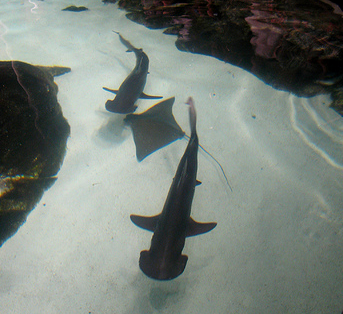| << Chapter < Page | Chapter >> Page > |
Unlike size segregation, social segregation is much more complex. Sharks tend to practice both habitat segregation and spatial segregation , both of which are types of social (sexual) segregation. Both biotic and abiotic factors influence how each sex approaches habitat selection (Conradt, 1998). Five different hypotheses exist, attempting to explain the variations in social segregation different species of elasmobranches were observed to practice (Wearmouth&Sims, 2008).
The predation-risk (reproductive strategy) hypothesis suggests that due to differences in rates of predation, both females and males act to maximize their reproductive potential by augmenting their behavior in order to lower their chances of being predated upon. On the other hand, forage selection (sexual dimorphism - body-size) hypothesis suggests that sexual dimorphism between the females and males create different nutritional needs, thus they feed in different areas according to prey densities. Alternately, the activity budget (body-size dimorphism) hypothesis suggests that sexual dimorphism creates conflict between the sexes due to different energy requirements, thus they separate to become more efficient. Thermal niche-fecundity hypothesis is similar to predation-risk hypothesis in that it suggests both sexes strive to maximize their lifetime reproductive success, but this hypothesis suggests that reproductive potential is maximized in the right temperature conditions rather than in lowered predation rates. Finally social factors (social preference and social avoidance) hypothesis focuses on how the sex-segregation is driven by social factors (sexual preferences) (Wearmouth&Sims, 2008).
Even though there is abundant evidence indicating that there is hardly a distinct social system within even socially segregated sharks, such as the Sychliorhinus canicula, the catshark, dominance hierarchy has been found to exist within Sphyrna tiburo, the bonnethead shark (Myrberg&Gruber, 1974).
Myrberg and Gruber found that within a group of 10 individuals, there is a distinct, size-dependent linear dominance hierarchy determined by size more than anything else. Similar to how a dog rolls over to show its belly to a higher ranked individual, the sharks act submissively before a higher ranked individual. When the courses of two sharks intersect, the lesser-ranked individual will abruptly change course to avoid the more dominant shark. Also, the order of a follow formation is believed to be in order of dominance, but this has yet to be proven.
However, one interesting fact was noted by the duo: more so than expected, the smaller sharks shied away more from the males of the group. Although reasons are unclear as to why male dominance is less size-correlated, Myrberg and Gruber attribute this behavior to fear. They reason that the violence exhibited by male bonnetheads during mating assert their dominance, along with fear, in the group.
Thus, even though most evidence indicate that segregation isn’t a voluntary action exhibited by sharks, such sexual segregation found in the sexually dimorphic scalloped hammerhead sharks, Sphyrna lewini, the fact that an established social hierarchy exists indicates that sharks are more rational than their stereotypically counterparts, or that they are still continuing their evolution into intellectual organisms from over 350 million years ago (Klimely, 1987)(Myrberg&Gruber, 1974)(Sims, 2003).

http://www.flickr.com/photos/danarah/159354894/

Notification Switch
Would you like to follow the 'Mockingbird tales: readings in animal behavior' conversation and receive update notifications?